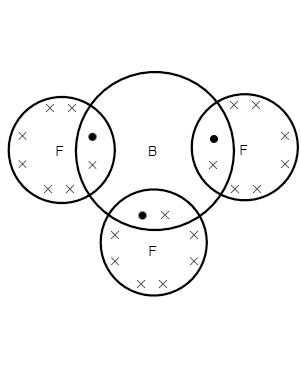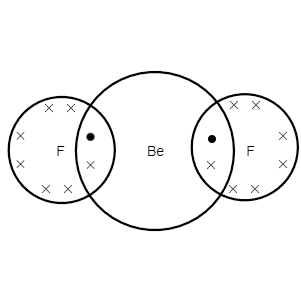
Give reason $Be{{F}_{2}}$ and $B{{F}_{3}}$ both are stable, yet each has incomplete octet. Why?
Answer
558k+ views
Hint: Electronic configuration shows the electrons that are distributed in a molecular or atomic orbital. A configuration that has the lowest electronic energy, it is known as ground state and the other configuration is excited state. A compound is said to be stable if it consists of 8 electrons in the outermost shell.
Complete step by step answer:
In $Be{{F}_{2}}$ and $B{{F}_{3}}$ , fluorine has lone pair of electrons, which are donated to the empty orbitals of beryllium and boron with the help of back bonding. Back bonding helps in stabilizing these compounds and hence, they exist even violating the octet rule.
1. $(B{{F}_{3}})$
As we can see, the atomic number of boron is $5$
The atomic number of an element is the number of protons in its atom.
The electronic configuration of boron is $1{{s}^{2}}2{{s}^{2}}2{{p}^{1}}$ .
we can see, the number of valence electrons in boron is $3$
as we can see, atomic number of fluorine is $9$
The electronic configuration of fluorine is $1{{s}^{2}}2{{s}^{2}}2{{p}^{5}}$
we can see, the valence shell electron in fluorine is $7$

Here, we can see that the three valence electrons of boron are bonded with one out of seven valence electrons of each fluorine atom.
$B{{F}_{3}}$ has six electrons for bonding, and therefore, it is electronic deficient.
2. $(Be{{F}_{2}})$
As we can see, the atomic number of beryllium is $4$
The electronic configuration of beryllium is $1{{s}^{2}}2{{s}^{2}}$ .
we can see, the number of valence electrons in beryllium is $2$
as we can see, atomic number of fluorine is $9$
The electronic configuration of fluorine is $1{{s}^{2}}2{{s}^{2}}2{{p}^{5}}$
we can see, the valence shell electron in fluorine is $7$

In this, two valence electrons of beryllium are bonded with one out of seven valence electrons of each fluorine atom.
$Be{{F}_{2}}$ has four electrons for bonding, and therefore, it is electronic deficient.
Note: Octet rule is defined as the rule for the main group elements that tend to bond in such a way that each atom contains eight electrons in their valence shell, forming electronic configuration as a noble gas. We can calculate valence electrons using Lewis dot structure.Octet rule is only applicable for main group elements.When an atom consists of less number of electrons and requires electrons for its stability, it is known as electron deficient.
Complete step by step answer:
In $Be{{F}_{2}}$ and $B{{F}_{3}}$ , fluorine has lone pair of electrons, which are donated to the empty orbitals of beryllium and boron with the help of back bonding. Back bonding helps in stabilizing these compounds and hence, they exist even violating the octet rule.
1. $(B{{F}_{3}})$
As we can see, the atomic number of boron is $5$
The atomic number of an element is the number of protons in its atom.
The electronic configuration of boron is $1{{s}^{2}}2{{s}^{2}}2{{p}^{1}}$ .
we can see, the number of valence electrons in boron is $3$
as we can see, atomic number of fluorine is $9$
The electronic configuration of fluorine is $1{{s}^{2}}2{{s}^{2}}2{{p}^{5}}$
we can see, the valence shell electron in fluorine is $7$

Here, we can see that the three valence electrons of boron are bonded with one out of seven valence electrons of each fluorine atom.
$B{{F}_{3}}$ has six electrons for bonding, and therefore, it is electronic deficient.
2. $(Be{{F}_{2}})$
As we can see, the atomic number of beryllium is $4$
The electronic configuration of beryllium is $1{{s}^{2}}2{{s}^{2}}$ .
we can see, the number of valence electrons in beryllium is $2$
as we can see, atomic number of fluorine is $9$
The electronic configuration of fluorine is $1{{s}^{2}}2{{s}^{2}}2{{p}^{5}}$
we can see, the valence shell electron in fluorine is $7$

In this, two valence electrons of beryllium are bonded with one out of seven valence electrons of each fluorine atom.
$Be{{F}_{2}}$ has four electrons for bonding, and therefore, it is electronic deficient.
Note: Octet rule is defined as the rule for the main group elements that tend to bond in such a way that each atom contains eight electrons in their valence shell, forming electronic configuration as a noble gas. We can calculate valence electrons using Lewis dot structure.Octet rule is only applicable for main group elements.When an atom consists of less number of electrons and requires electrons for its stability, it is known as electron deficient.
Recently Updated Pages
Why are manures considered better than fertilizers class 11 biology CBSE

Find the coordinates of the midpoint of the line segment class 11 maths CBSE

Distinguish between static friction limiting friction class 11 physics CBSE

The Chairman of the constituent Assembly was A Jawaharlal class 11 social science CBSE

The first National Commission on Labour NCL submitted class 11 social science CBSE

Number of all subshell of n + l 7 is A 4 B 5 C 6 D class 11 chemistry CBSE

Trending doubts
1 Quintal is equal to a 110 kg b 10 kg c 100kg d 1000 class 11 physics CBSE

What is Environment class 11 chemistry CBSE

Bond order ofO2 O2+ O2 and O22 is in order A O2 langle class 11 chemistry CBSE

How many squares are there in a chess board A 1296 class 11 maths CBSE

Distinguish between verbal and nonverbal communica class 11 english CBSE

The equivalent weight of Mohrs salt FeSO4 NH42SO4 6H2O class 11 chemistry CBSE




